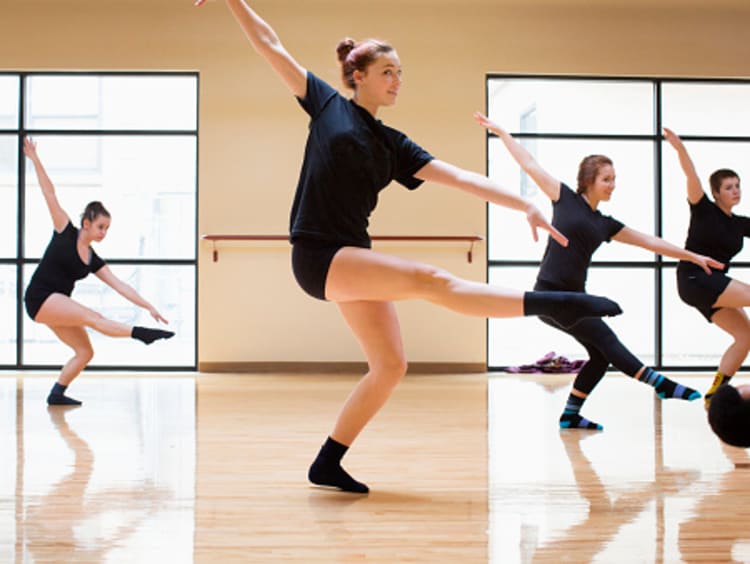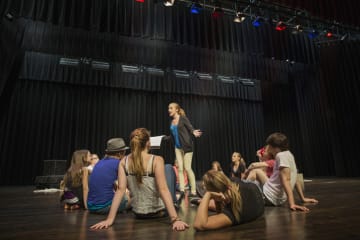How To Improve Balance as a Dancer

One of the most impressive skills of a professional dancer is balance. Balance is the state of bodily symmetry characterized by complete stillness and minimal postural swaying. Balance is not a matter of remaining still in position but continually shifting the body and making necessary adjustments in alignment. Balance is affected by many things within the body and is something dancers are constantly trying to improve.
Luckily, there are practical ways to improve balance by applying the following techniques and exercises.
Balance Exercises for a Solid Base
One of the keys to improving balance is increasing the mobility and strength in a part of the body people usually don’t give much thought to—the ankles! If your base is unstable and wobbly, you won’t be able to balance for long periods of time. Your calf muscles play an important role in protecting the ankles. To improve your dance technique, one balance exercise you can do to stretch this muscle is a calf stretch.
- Stand facing a wall and place your hands on a wall.
- Step one foot back keeping both legs parallel. The goal of this exercise is to have your entire back foot on the floor. If your back heel is not on the floor, shorten your stance.
- Lean your weight into the wall until you feel a stretch in the calf.
- Hold this stretch for up to a minute. Then switch legs.
Core Strength Training
Strengthening muscles in the ankles and foot can help with balance but one can’t achieve total mastery without an engaged and strong core. Your core consists of your abdominals, obliques and back muscles. A strong core is the key to finding your stability while you are balancing. Yoga and Pilates are great core strength training activities, as are exercises like the plank, side plank and bicycle crunches.
- Start in plank position on your hands with your head looking down and your shoulders pressing down. Hold in plank position for 30 seconds to one minute.
- Transition to side plank by planting one arm on the ground and the other reaching for the sky. Legs are stacked on top of each other and spend another 30 seconds to one minute on each side, transitioning through plank position to get to the other side.
- After side planks, find your way to your back to complete bicycle crunches. Your hands will go behind your head with elbows out. Legs will take turns bending and straightening and you will twist your body toward the leg that is bent. Make sure your shoulders are lifted from the floor. The focus of this exercise is to work on your obliques.
Find a Focus Point
Another way to improve balance and become a better dancer is to direct your eyes toward a spot on the wall. Choose an area in front of you that stands out to keep your balance longer. Whatever you do, make sure to keep your eyes off the floor. They should be lifted because wherever your focus is, your body will follow, and you want your body to be as lifted as possible. If you look down, you go down. Practice looking at yourself in the mirror when balancing and then move away from the mirror to try spotting something else in front of you.
Ditch the Barre
The barre is a great tool for dancers to practice and improve their dance technique before going into the center. Once you can do a movement well at the barre, you should challenge yourself to move without the extra assistance the barre provides. Learning to balance, especially in the center, is all about trial and error. Don’t get discouraged if you don’t get it the first few times. Be positive and tell yourself you can do it. A helpful tip is to imagine yourself balancing perfectly beforehand.
Your base of support is constantly changing while dancing so you should do everything necessary to make sure you set yourself up for success. Practicing exercises that focus on the ankles and core a couple times a week will allow you to see improvements in balance. Whether you are a beginner or advanced dancer, having good stability and balance will allow you to go through movements with more ease and fluidity.
At Grand Canyon University (GCU), we offer a Bachelor of Arts in Dance and Bachelor of Arts in Dance for Secondary Education for those who looking at a future career in the arts. Students participate in master classes and intensives to learn how to improve dance techniques and grow as dancers, choreographers and artists. To learn more, select the “Request Info” at the top of your screen.
The views and opinions expressed in this article are those of the author’s and do not necessarily reflect the official policy or position of Grand Canyon University. Any sources cited were accurate as of the publish date.


